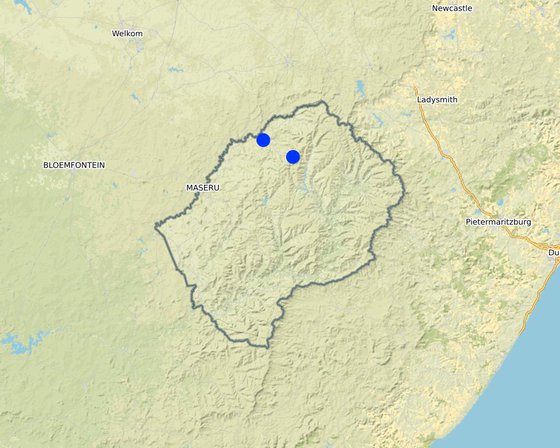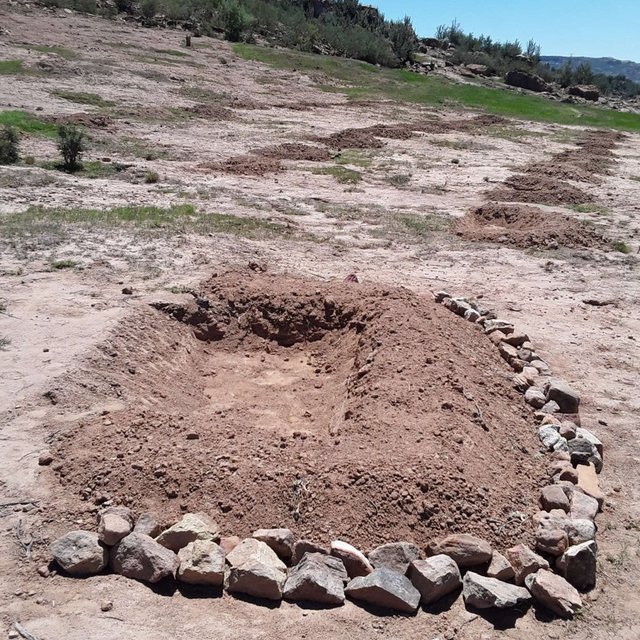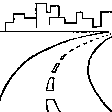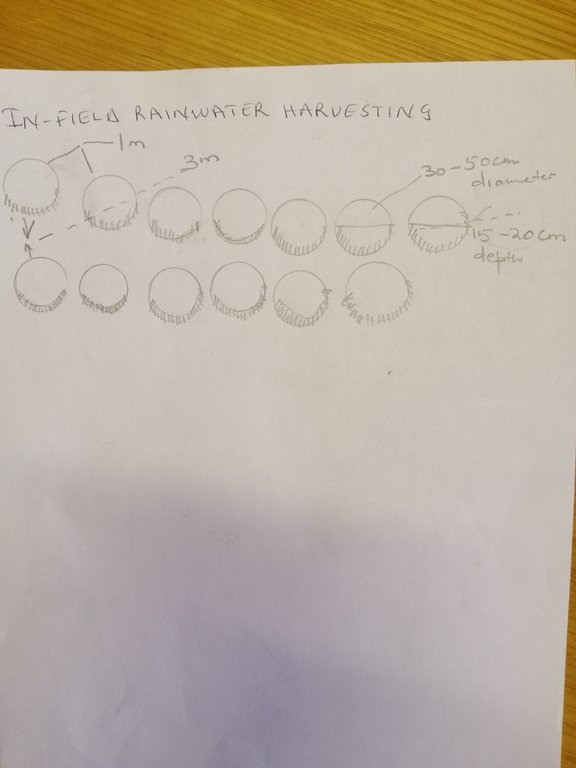



The technology is applied on natural marginal environment where the land is dry, they pits are mostly dug on the rangeland. The purpose is to harvest rain water/surface runoff consequently recharge soil moisture and support plant available water as highly as possible. After some time, there will be regeneration of vegetation. The dimensions of this structure may differ according to soil type, slope and rainfall intensity.
To construct this activity, the land should be bare or poor in plant biodiversity. Firstly, the extension workers hold public gatherings for a concerned community to make them aware of the land degradation in their area and possible solutions. In field rain water harvesting pits being one of them. The area is then surveyed using survey equipment (this is a technical survey not the one which uses questionnaires, this survey uses equipment such as theodolyte, auto cat etc). It is important to do the area survey because the technology follows the contour lines, otherwise it is likely to cause more harm on the land. The design of the technology is laid out by using the measuring tape, pick axe and spade. Construction starts from the top of field. Pits are dug in succession in a row following the contour with in row (intrarow) spacing of 1 m, pit depth of 20-30 cm and width of 1 m. Interrow spacing (between rows) is 3 m at 12% slope. After construction, kikuyu grass is sown around the pits to protect them from erosion. After the first storm, the area is then revisited for maintenance and repairs if need be. This technology is beneficial mostly in drylands where the water shortage is a major problem to improve land productivity. Although specififications are in this manner, this technology can be adapted differently in other areas depending on the amount of precipitation received by a certain area. For instance, some pits can be bigger or smaller than the given specifications.
The land users found it beneficial because the inputs needed to construct this technology are locally available such as spade, pick axe and grass for sodding. Furthermore, the rehabilitation benefits accrue within a short while. In addition, the technology is easy to construct. However, the land users found it tedious as they have to maintain it after every storm. The pits can be constructed on the rangeland and cropland which is no longer productive. in this era of climate change where this part of Southern Africa is becoming more dry everyday, this technology is even more applicable.

ສະຖານທີ່: Peri-Urban, Leribe District, ລີໂຊໂທ
ຈໍານວນ ພື້ນທີ່ ທີ່ໃຊ້ ເຕັກໂນໂລຢີ ທີ່ໄດ້ວິເຄາະ: ພື້ນທີ່ດຽວ
ການແຜ່ກະຈາຍຂອງເຕັກໂນໂລຢີ: ນໍາໃຊ້ໃນຈຸດສະເພາະ / ແນໃສ່ນໍາໃຊ້ໃນພື້ນທີ່ຂະໜາດນ້ອຍ
ຢູ່ໃນເຂດປ່າສະຫງວນທີ່ບໍ?: ບໍ່ແມ່ນ
ວັນທີຂອງການປະຕິບັດ: 2019
ປະເພດຂອງການນໍາສະເໜີ


| ສາຍພັນ | ນັບ |
| ສັດໃຫ່ຍ-ງົວພັນຊີ້ນ | 207 |
| ແກະ | 1307 |












| ລະບຸ ປັດໃຈ ນໍາເຂົ້າ ໃນການຜະລີດ | ຫົວໜ່ວຍ | ປະລິມານ | ຕົ້ນທຶນ ຕໍ່ຫົວໜ່ວຍ (USA) | ຕົ້ນທຶນທັງໝົດ ຂອງປັດໃຈຂາເຂົ້າ ໃນການຜະລິດ (USA) | % ຂອງຕົ້ນທຶນທັງໝົດ ທີ່ຜູ້ນໍາໃຊ້ທີ່ດິນ ໃຊ້ຈ່າຍເອງ |
| ແຮງງານ | |||||
| one person | person-days | 1.0 | 5.0 | 5.0 | 5.0 |
| ອຸປະກອນ | |||||
| pick axe | piece | 1.0 | 15.0 | 15.0 | |
| spade | piece | 1.0 | 13.0 | 13.0 | |
| measuring tape | piece | 1.0 | 8.0 | 8.0 | |
| ວັດສະດຸໃນການປູກ | |||||
| grass seed | kg | 2.0 | 13.0 | 26.0 | 25.0 |
| ວັດສະດຸກໍ່ສ້າງ | |||||
| stones | piece | 40.0 | 1.0 | 40.0 | |
| ຕົ້ນທຶນທັງໝົດ ໃນການຈັດຕັ້ງປະຕິບັດ ເຕັກໂນໂລຢີ | 107.0 | ||||
| ຄ່າໃຊ້ຈ່າຍທັງໝົດ ສຳລັບການສ້າງຕັ້ງເຕັກໂນໂລຢີ ເປັນສະກຸນເງີນໂດລາ | 107.0 | ||||
| ລະບຸ ປັດໃຈ ນໍາເຂົ້າ ໃນການຜະລີດ | ຫົວໜ່ວຍ | ປະລິມານ | ຕົ້ນທຶນ ຕໍ່ຫົວໜ່ວຍ (USA) | ຕົ້ນທຶນທັງໝົດ ຂອງປັດໃຈຂາເຂົ້າ ໃນການຜະລິດ (USA) | % ຂອງຕົ້ນທຶນທັງໝົດ ທີ່ຜູ້ນໍາໃຊ້ທີ່ດິນ ໃຊ້ຈ່າຍເອງ |
| ແຮງງານ | |||||
| grass seed | kg | 1.0 | 13.0 | 13.0 | |
| one person | person day | 1.0 | 5.0 | 5.0 | |
| ຕົ້ນທຶນທັງໝົດ ທີ່ໃຊ້ໃນການບໍາລຸງຮັກສາ ເຕັກໂນໂລຢີ | 18.0 | ||||
| ຄ່າໃຊ້ຈ່າຍທັງໝົດ ສຳລັບການບົວລະບັດຮກສາເຕັກໂນໂລຢີ ເປັນສະກຸນເງີນໂດລາ | 18.0 | ||||
The area is found in the peri-urban zone which is near the major town of Hlotse. There are access roads and they are closer to markets.
ປະລິມານ ກ່ອນການຈັດຕັ້ງປະຕິບັດ ການຄຸ້ມຄອງ ທີ່ດິນແບບຍືນຍົງ: vegetation cover was poor
ປະລີມານ ຫຼັງການຈັດຕັ້ງປະຕິບັດ ການຄຸ້ມຄອງ ທີ່ດິນແບບຍືນຍົງ: increased vegetation cover
quantity increased after SLM
ປະລິມານ ກ່ອນການຈັດຕັ້ງປະຕິບັດ ການຄຸ້ມຄອງ ທີ່ດິນແບບຍືນຍົງ: fodder quality was also poor
ປະລີມານ ຫຼັງການຈັດຕັ້ງປະຕິບັດ ການຄຸ້ມຄອງ ທີ່ດິນແບບຍືນຍົງ: increased quality
There is now fodder available for animals
ປະລິມານ ກ່ອນການຈັດຕັ້ງປະຕິບັດ ການຄຸ້ມຄອງ ທີ່ດິນແບບຍືນຍົງ: land was poorly managed
ປະລີມານ ຫຼັງການຈັດຕັ້ງປະຕິບັດ ການຄຸ້ມຄອງ ທີ່ດິນແບບຍືນຍົງ: community members agreed to protect the land
The pits constructed have contributed positively to increase in land cover, land productivity and soil organic carbon
ປະລິມານ ກ່ອນການຈັດຕັ້ງປະຕິບັດ ການຄຸ້ມຄອງ ທີ່ດິນແບບຍືນຍົງ: animals were too weak
ປະລີມານ ຫຼັງການຈັດຕັ້ງປະຕິບັດ ການຄຸ້ມຄອງ ທີ່ດິນແບບຍືນຍົງ: the quality of stock improved
The technology has contributed positively towards availability of fodder hence good animal production
ປະລິມານ ກ່ອນການຈັດຕັ້ງປະຕິບັດ ການຄຸ້ມຄອງ ທີ່ດິນແບບຍືນຍົງ: biodiversity was lost
ປະລີມານ ຫຼັງການຈັດຕັ້ງປະຕິບັດ ການຄຸ້ມຄອງ ທີ່ດິນແບບຍືນຍົງ: regeneration of biodiversity
both birds and wild animals are now occupying the habitat, communities use rehabilitated areas as parks or picnic area, and people pay to access that part of the land. The revenue collected will then be used for other purposes that might help community such as fixing a broken water tap etc.
ປະລິມານ ກ່ອນການຈັດຕັ້ງປະຕິບັດ ການຄຸ້ມຄອງ ທີ່ດິນແບບຍືນຍົງ: community members did not have knowledge of the technology
ປະລີມານ ຫຼັງການຈັດຕັ້ງປະຕິບັດ ການຄຸ້ມຄອງ ທີ່ດິນແບບຍືນຍົງ: community members can now construct the pits on their own in their own land
knowledge on land degradation now improved
ປະລິມານ ກ່ອນການຈັດຕັ້ງປະຕິບັດ ການຄຸ້ມຄອງ ທີ່ດິນແບບຍືນຍົງ: water was not collected
ປະລີມານ ຫຼັງການຈັດຕັ້ງປະຕິບັດ ການຄຸ້ມຄອງ ທີ່ດິນແບບຍືນຍົງ: surface run-off was now collected
a lot of water is now collected through this technology and not lost like it used to be
ປະລິມານ ກ່ອນການຈັດຕັ້ງປະຕິບັດ ການຄຸ້ມຄອງ ທີ່ດິນແບບຍືນຍົງ: surface runoff was not controlled
ປະລີມານ ຫຼັງການຈັດຕັ້ງປະຕິບັດ ການຄຸ້ມຄອງ ທີ່ດິນແບບຍືນຍົງ: surface run-off was partly collected
surface run-off now partly collected and soil erosion minimised
ປະລິມານ ກ່ອນການຈັດຕັ້ງປະຕິບັດ ການຄຸ້ມຄອງ ທີ່ດິນແບບຍືນຍົງ: poor surface drainage
ປະລີມານ ຫຼັງການຈັດຕັ້ງປະຕິບັດ ການຄຸ້ມຄອງ ທີ່ດິນແບບຍືນຍົງ: infiltration improved drainage
surface drainage was controlled to enhance infiltration
ປະລິມານ ກ່ອນການຈັດຕັ້ງປະຕິບັດ ການຄຸ້ມຄອງ ທີ່ດິນແບບຍືນຍົງ: prolonged dry-moist dry
ປະລີມານ ຫຼັງການຈັດຕັ້ງປະຕິບັດ ການຄຸ້ມຄອງ ທີ່ດິນແບບຍືນຍົງ: conditional moisture
improved
ປະລິມານ ກ່ອນການຈັດຕັ້ງປະຕິບັດ ການຄຸ້ມຄອງ ທີ່ດິນແບບຍືນຍົງ: the land was bare
ປະລີມານ ຫຼັງການຈັດຕັ້ງປະຕິບັດ ການຄຸ້ມຄອງ ທີ່ດິນແບບຍືນຍົງ: revegetation
improved vegetation abundance
ປະລິມານ ກ່ອນການຈັດຕັ້ງປະຕິບັດ ການຄຸ້ມຄອງ ທີ່ດິນແບບຍືນຍົງ: sheet erosion
ປະລີມານ ຫຼັງການຈັດຕັ້ງປະຕິບັດ ການຄຸ້ມຄອງ ທີ່ດິນແບບຍືນຍົງ: sheet erosion disrupted
surface roughness improved
ປະລິມານ ກ່ອນການຈັດຕັ້ງປະຕິບັດ ການຄຸ້ມຄອງ ທີ່ດິນແບບຍືນຍົງ: much soil loss
ປະລີມານ ຫຼັງການຈັດຕັ້ງປະຕິບັດ ການຄຸ້ມຄອງ ທີ່ດິນແບບຍືນຍົງ: sedimentation improved
sediment is collected in ditches
ປະລິມານ ກ່ອນການຈັດຕັ້ງປະຕິບັດ ການຄຸ້ມຄອງ ທີ່ດິນແບບຍືນຍົງ: bare ground
ປະລີມານ ຫຼັງການຈັດຕັ້ງປະຕິບັດ ການຄຸ້ມຄອງ ທີ່ດິນແບບຍືນຍົງ: above ground biomass improved
improved soil moisture supports biomass production
ປະລິມານ ກ່ອນການຈັດຕັ້ງປະຕິບັດ ການຄຸ້ມຄອງ ທີ່ດິນແບບຍືນຍົງ: few species
ປະລີມານ ຫຼັງການຈັດຕັ້ງປະຕິບັດ ການຄຸ້ມຄອງ ທີ່ດິນແບບຍືນຍົງ: species variety
various species require availed prolonged soil moisture
ປະລິມານ ກ່ອນການຈັດຕັ້ງປະຕິບັດ ການຄຸ້ມຄອງ ທີ່ດິນແບບຍືນຍົງ: less carbon stored in the soil
ປະລີມານ ຫຼັງການຈັດຕັ້ງປະຕິບັດ ການຄຸ້ມຄອງ ທີ່ດິນແບບຍືນຍົງ: improved carbon sequestration
soil organic carbon improved